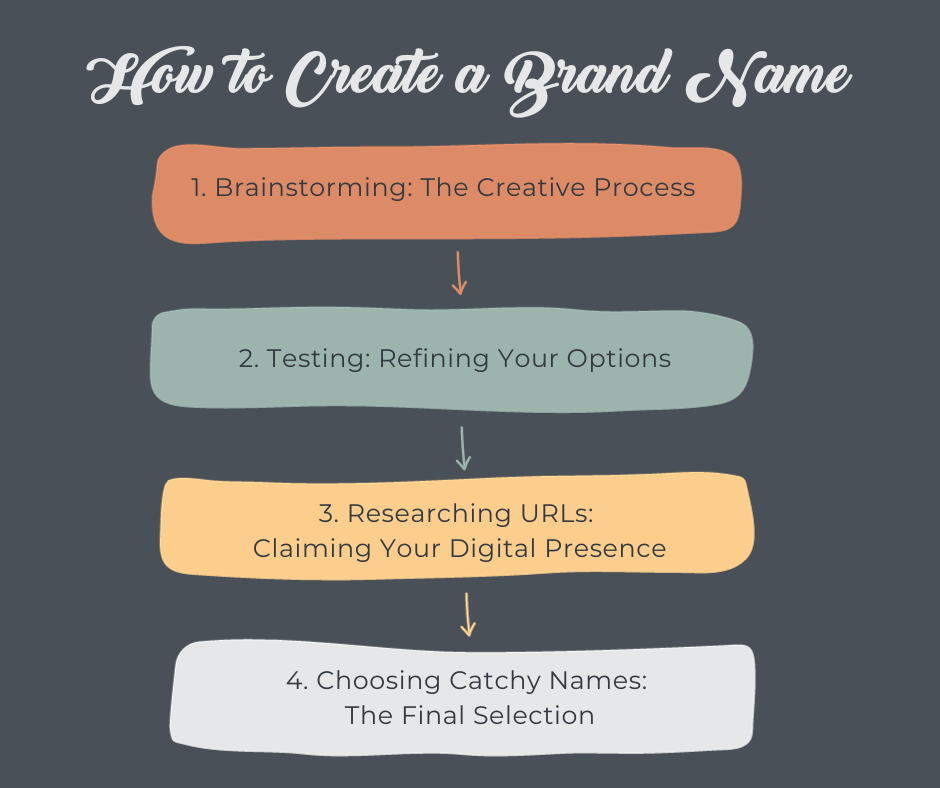You’re Ready to Launch – Let’s Talk Brand Names
So, you’re starting your own business, launching a new product, or revamping your personal brand? Heck yes! Big congrats—you’re about to dive into an exciting journey, and it all kicks off with one major move: choosing the perfect business name.
In this guide, we’ll walk you through brainstorming, testing, checking URLs, and ultimately landing on a name that feels just right.
You might be wondering, “How do I even create my own brand name?” Don’t worry, we’ve got you. Your brand name is your first impression—it’s what people will remember, talk about, and associate with everything you stand for. It should be catchy, memorable, and totally you.

The Creative Process: Time to Brainstorm
Your brand name is like your signature—it should reflect your vibe and what you’re all about. First things first: let’s get creative and brainstorm a ton. The more ideas, the better.
Start with words that relate to your product or service. If you’re opening a bakery, maybe words like “sweets,” “treats,” or “yum” spark something fun.
Then let your brain wander. Sometimes the coolest names come from totally unexpected word mashups or random thoughts. Thesauruses are great for finding synonyms, and playing with acronyms can lead to something short and punchy (hello, NASA vibes).
Look into other languages for words that reflect your brand’s essence—just double-check meanings so nothing gets lost (or awkward) in translation. Portmanteaus (like Instagram = instant + telegram) are always a creative twist, and even intentional misspellings can give you something fresh and memorable (think Flickr).
Got a cool backstory? Use it. Names with a story behind them often have more impact and staying power.
The goal here is to throw everything on the table. No bad ideas—just let it flow.
Narrow It Down: Time to Test
Okay, you’ve got a solid list. Now let’s trim it down and make sure your top picks really shine.
Think about your audience—what would resonate with them? It helps to get honest feedback from people who represent your ideal customer.
Next, check out social media. Are the handles available? Consistency across platforms is key to building recognition.
This is also the time to check for trademark availability—no one wants legal drama down the road. Do a quick search through the USPTO or your country’s trademark office.
And don’t forget to research domain name availability. Ideally, your name and domain should match or be super close for easy online discovery.
If you can, test your favorites with a focus group. Their opinions can bring valuable insight (and maybe point out something you missed).
Make sure your name has no weird or negative meanings in other languages or cultures. And say it out loud—does it roll off the tongue? Is it easy to remember? Try visualizing it in different fonts, colors, and logo styles to see how it might look on your website or signage.
Claim Your Digital Home: Researching URLs
These days, your website is often the first place people find you, so your domain is a big deal. You want it short, sweet, and easy to type.
While .com is the go-to, don’t be afraid to explore other extensions like .co, .net, or country-specific ones like .ca or .uk. Sometimes they help your brand stand out even more.
Use tools like GoDaddy, Namecheap, or Google Domains to check if your dream domain is available. If it’s taken, it might be worth checking domain auctions—you could still snag it for a fair price.
It’s also smart to grab similar domain names to protect your brand from imposters or competitors.
And don’t forget about domain privacy protection to keep your personal info safe.
Keep it short, memorable, and mobile-friendly. Your domain name is also great for creating pro email addresses like hello@yourbrand.com.
The Final Pick: Choosing That Catchy Name
Alright, you’ve brainstormed, tested, and secured your domain. Now comes the best part—picking the name that really clicks.
Ask yourself: Does it feel right emotionally? Does it spark connection or curiosity?
A great brand name is one people remember after seeing or hearing it just once. It should be unique enough to stand out, but still easy to say and spell.
Avoid anything too trendy or limiting—choose a name with staying power that will still feel relevant in 5 or 10 years.
Picture it in your logo, your social posts, your packaging. Does it look as good as it sounds?
And, of course, make sure the domain still matches. Consistency is everything.
Before you lock it in, run it by some trusted friends or even a focus group. But at the end of the day—trust your gut. If it makes you smile and fits your vision, go for it!
Wrapping It Up
Creating a memorable brand name is part creativity, part strategy, and totally worth the effort. Start with wild brainstorming, test your ideas with real people, secure your spot online, and pick a name that truly reflects your vision.
Your brand name isn’t just a name—it’s the launchpad for your business adventure. So take your time, have fun with it, and choose a name that you’ll be proud to stand behind for years to come.
